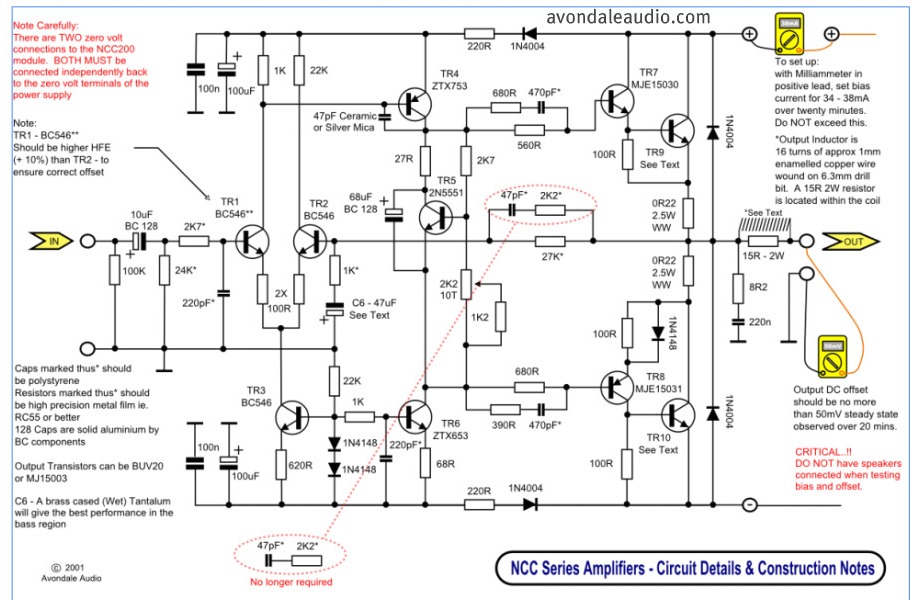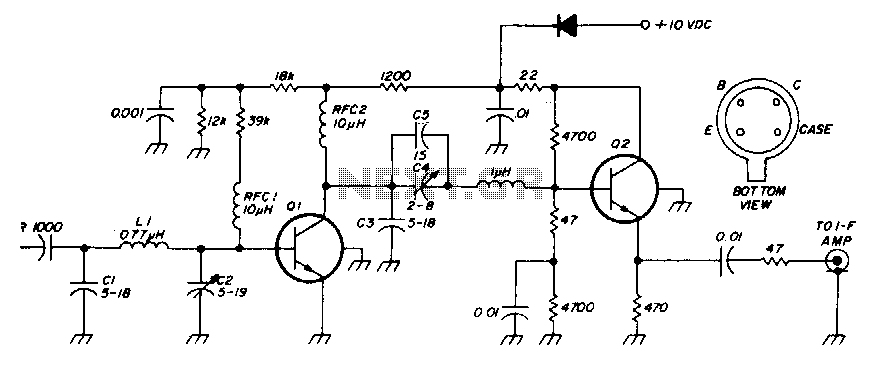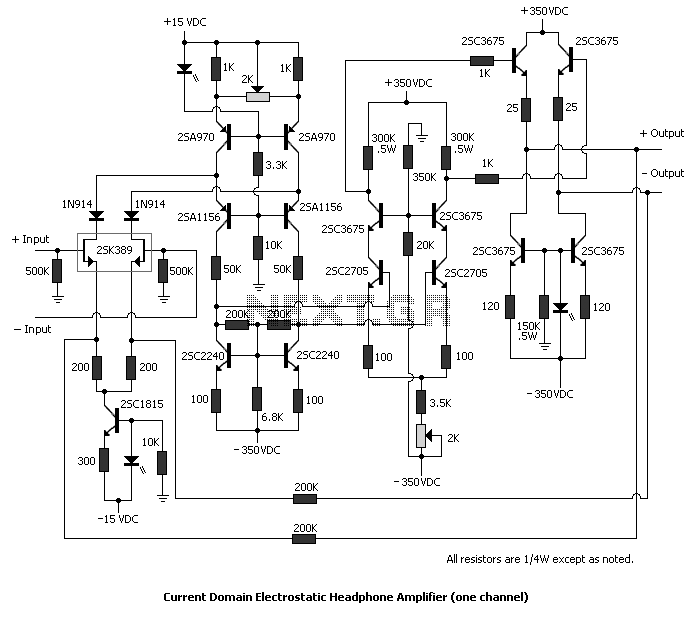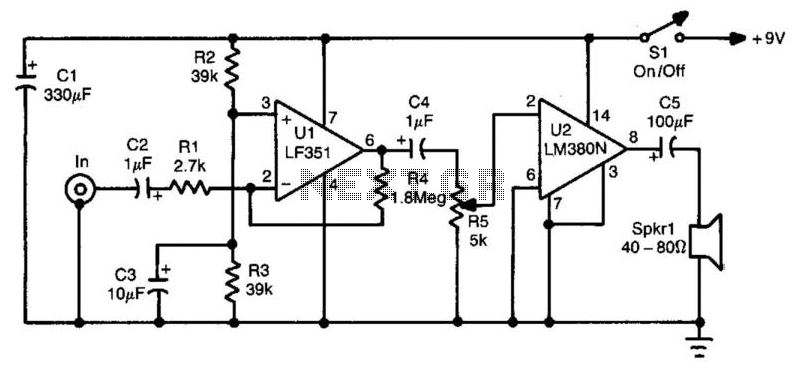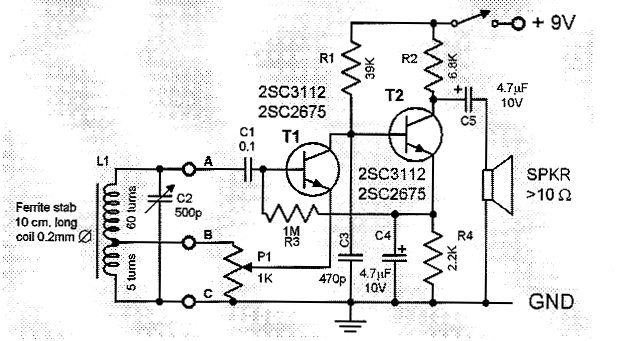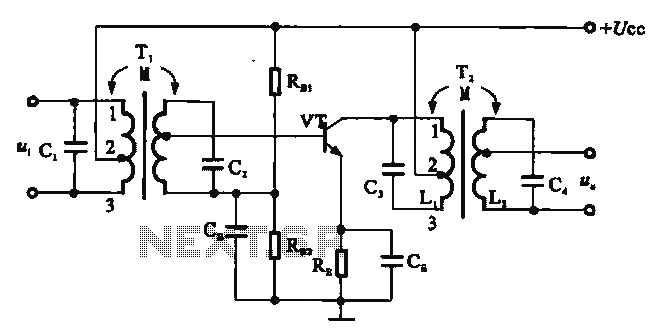
Voice amplifier transistor
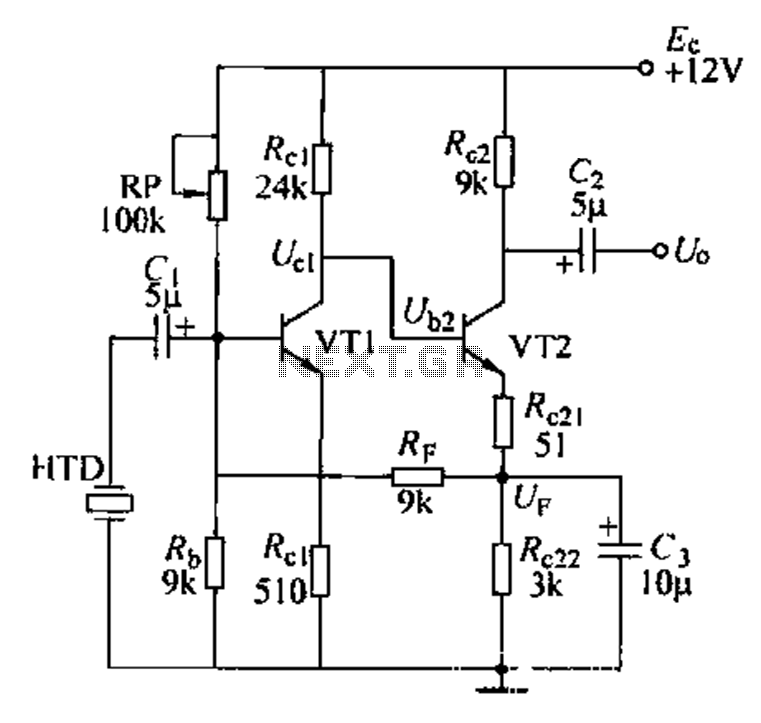
Dctl is a two-stage amplifier, with the first stage amplifying the collector voltage of transistor VT1. The second stage, represented by VT2, is proportional to the current flowing through the winding. The RF signal is applied to the sub-base of VT1. The circuit gain is equal to the product of the two stages' magnifications. The operation involves a feedback process: when the emitter current increases, the resistance R1 rises, causing a partial pressure increase, which in turn increases the voltage at the output. This creates a condition where conduction is maintained at a low degree, allowing the resistor to return to normal operation, thereby achieving the desired amplification. The transistor is directly coupled in a negative feedback configuration, providing not only voltage amplification but also improved performance. In this circuit, there is no bypass capacitor added to VT1, indicating that it functions as an AC feedback circuit. Although some gain is lost, the operation remains effective. The resistance is divided into parts, with R2 added directly without exchange.
Dctl operates as a two-stage amplifier designed to enhance signal strength through careful modulation of transistor behavior. The first stage utilizes transistor VT1 to amplify the collector voltage, while the second stage, represented by transistor VT2, modulates the output based on the current flowing through the associated winding. The RF signal, applied to the sub-base of VT1, plays a crucial role in determining the overall gain of the circuit, which is calculated as the product of the individual magnifications from both stages.
The feedback mechanism is integral to the circuit's functionality. When the emitter current rises, the resistance R1 experiences an increase, leading to a rise in partial voltage. This change results in a corresponding increase in the output voltage (Vn), which influences the conduction state of the transistors. As conduction is maintained at a lower degree, the resistor returns to its normal operating conditions, facilitating consistent performance and achieving the desired amplification effect.
The direct coupling of transistors in a negative feedback configuration is particularly noteworthy. This arrangement not only provides robust voltage amplification but also enhances overall performance by stabilizing the circuit against fluctuations. The absence of a bypass capacitor in the configuration of VT1 signifies that the feedback is purely AC-based, allowing for effective signal processing while sacrificing some gain.
Additionally, the division of resistance into distinct parts, with R2 incorporated directly into the circuit, underscores the design's emphasis on simplicity and efficiency. The straightforward approach to resistance management ensures that the amplifier can maintain operational integrity without unnecessary complexity, making it suitable for various applications in electronic signal amplification.Dctl is a two-stage amplifier, the first stage amplifying transistor VT1 collector voltage U and by vt2 1 proportional to current rf, uf through wind and after rf applied sub-base of vt1. circuit gain equal product two magnification. operation given feedback process as follows: when emitter increases, rise high r1, r partial pressure, so ultl increased. vn which makes conduction save degree low, flowing resistor reduction resume normal work, achieve purpose operation, transistor direct-coupled negative put dog, not only has electrical pressure magnification, performance.
in circuit, vt1 rf. no bypass capacitor added, indicating that it just a ac feedback. this lost though some magnification + get operation. resistance divided into parts, re2 added g, direct without exchange
Dctl operates as a two-stage amplifier designed to enhance signal strength through careful modulation of transistor behavior. The first stage utilizes transistor VT1 to amplify the collector voltage, while the second stage, represented by transistor VT2, modulates the output based on the current flowing through the associated winding. The RF signal, applied to the sub-base of VT1, plays a crucial role in determining the overall gain of the circuit, which is calculated as the product of the individual magnifications from both stages.
The feedback mechanism is integral to the circuit's functionality. When the emitter current rises, the resistance R1 experiences an increase, leading to a rise in partial voltage. This change results in a corresponding increase in the output voltage (Vn), which influences the conduction state of the transistors. As conduction is maintained at a lower degree, the resistor returns to its normal operating conditions, facilitating consistent performance and achieving the desired amplification effect.
The direct coupling of transistors in a negative feedback configuration is particularly noteworthy. This arrangement not only provides robust voltage amplification but also enhances overall performance by stabilizing the circuit against fluctuations. The absence of a bypass capacitor in the configuration of VT1 signifies that the feedback is purely AC-based, allowing for effective signal processing while sacrificing some gain.
Additionally, the division of resistance into distinct parts, with R2 incorporated directly into the circuit, underscores the design's emphasis on simplicity and efficiency. The straightforward approach to resistance management ensures that the amplifier can maintain operational integrity without unnecessary complexity, making it suitable for various applications in electronic signal amplification.Dctl is a two-stage amplifier, the first stage amplifying transistor VT1 collector voltage U and by vt2 1 proportional to current rf, uf through wind and after rf applied sub-base of vt1. circuit gain equal product two magnification. operation given feedback process as follows: when emitter increases, rise high r1, r partial pressure, so ultl increased. vn which makes conduction save degree low, flowing resistor reduction resume normal work, achieve purpose operation, transistor direct-coupled negative put dog, not only has electrical pressure magnification, performance.
in circuit, vt1 rf. no bypass capacitor added, indicating that it just a ac feedback. this lost though some magnification + get operation. resistance divided into parts, re2 added g, direct without exchange
